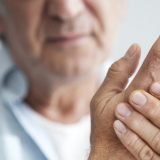Spondylolysis and Spondylolisthesis
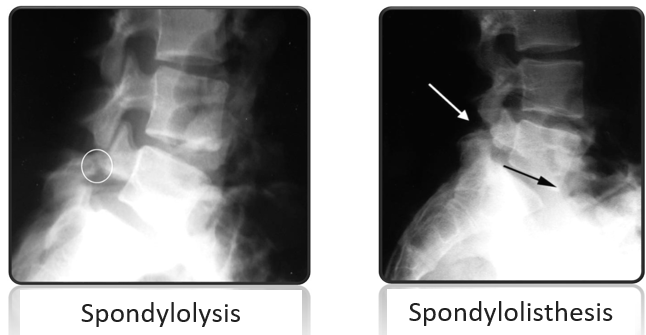

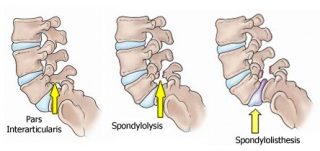
Lower back health is an essential element for modern people who spend a lot of time sitting down. One of the most common problems with people with back pain is Spondylolysis and Spondylolisthesis. There are many reasons for the development of the disease, but if you have a special congenital disease, accident, or cause, you can think first of all when it comes to the deterioration of the sacroiliac joint that occurs when you are sitting in an uncomfortable position for a long time.
The sacroiliac joint is the place where stability is really important in the body. When a person stands, the force that pushes the ground (the force of “action reaction” coming from the legs) and the potential energy from the upper body are met and this place makes up your body’s stability by offsetting no extra power.
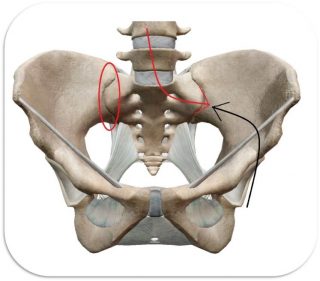
Sacroiliac joint and Force Offset
If there is an extra force remaining between the two forces that cannot be cancelled, the force will have a directionality, which will result in the sacroiliac joints having no stability. In order to help with this stability, the surrounding muscle tissue contracts excessively and causes various pain. If you project this situation in a sitting position, you will have the power of action reaction from the hip side sitting on the chair instead of the force coming from the leg when sitting down. These forces do not effectively cancel all gravitational energy from the upper body. Therefore, in order to maintain the stability of the body by the presence of extra force, we should maintain the stability of the waist by compressing the iliopsoas muscles mentioned in the last issue a little more.
Of course there is no problem with sitting itself. There is only a simple backache and a tingling sensation. The problem can be caused by leisure activities in the weekend, other than sitting down at work from Monday to Friday. For example, from Monday to Friday, with a sitting posture, the strong contraction of the iliopsoas muscle is created, and the broken movement of the weekend causes the iliopsoas muscle to pull down the spine in front of and down the body along with the axial compression. Therefore, 1) strong axial compression causes the vertebrae to collide with each other, and the continuous bending creates a fracture of the cervical spine. 2) This force acts on the anterior part of the vertebrae connected to the muscles, not the upper and lower muscles, so it has a great influence on the fracture of the cervical vertebrae. When one side of the palate gets fractured, the other side is giving weight, which results in back pain, stiffness of the back and legs, pain in the back of the thigh, hamstring and constant pain in the buttock muscles.
When a fracture of the palate occurs, the upper and lower lumbar spine is not fully engaged, and the sustained pressure cannot withstand the spinal bone pushing forward. These symptoms are called Spondylolisthesis. When anterior translocation develops, back pain becomes worse and the spine bones stimulate the nerve to cause radial and neuralgia symptoms of the sciatic nerve.
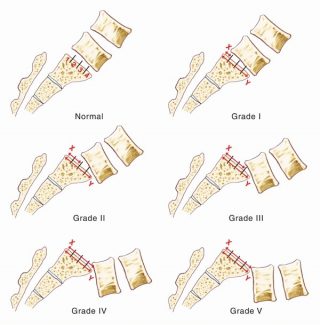
Stages of Spondylolisthesis:
Grade 1=25%; 2=50%; 3=75%; 4=~100%; 5=>100%
Diagnosis and treatment are determined by the percentage and stage of the patients when they have undergone X – ray, MRI, or CT, and usually both sides of the palate are fractured and more than 50% of Spondylolisthesis is occurring. If this epidural block is difficult to maintain, a spinal fixation that fixes the vertebra bone with a metal screw is performed.In the American orthopedic journals, they advise you to overcome mild symptoms with posture correction or exercise. The basic approach is to bring down the spinal muscles pulling forward to its normal function (it does not absolutely relax muscle loosening, it does not function when it relaxes.) It is a definite kinetic approach that can help you to put and maintain pressure on the waist. At this time, the movement of the multifidus muscle which can support the back from the back is absolute. At this time, other erector spinae muscle and quadratus lumborum muscle may cause back pain so it is crucial that pressure is only put on the multifidus muscle.
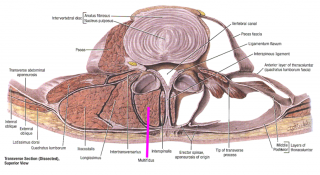
Profile of the lower back: Marked = Multifidus muscle
This is because the quadratus lumborum muscle and iliopsoas muscles are composed of one fascia and attached to the diaphragm. Therefore, if one of the two muscles play a major role, the other two muscles work together. At this time, the overworked iliopsoas muscle pulls the vertebra further forward, which can further aggravate the symptoms. Therefore, it is necessary to exercise the multifidus muscle separately. It is the exercise that I explained about the core muscle before.
First, bend your knees to about 90 degrees and look at the ceiling. Lift your pelvis and gently swing left and right to loosen your back muscles, then look down from the top to the bottom. When you put your hands on your lumbar spine for a while, you will not have space for your hands. At this time, put your hands on your back, gently put your back on the back of your hand, about 2 ~ 5 cm around your waist with the power of the waist and hold for 10 ~ 60 seconds. Because it is surrounded by the fascia, it is very easy to stimulate the muscle by producing static contraction or “isometric contraction” because the surrounding fascia is firmly resisting the muscle posture even with a small force.
Any hidden disease can be identified if one knows the special signs and symptoms they have. I will teach you how to check at home. First of all, we need help from other people around. Straighten your waist in a sitting position and get someone to run their fingers along the middle line of the spine. If there is a place where it leaps out and gets stuck in your hand, sit down, lie sideways, lean and check again. If you have a lump in every posture, or if you have stiff legs or persistent back pain, you may want to talk to an expert.
In the next issue, I will continue to deal with the musculoskeletal disorders you are wondering about. If you have any questions, please contact info@backpro.co.nz.


